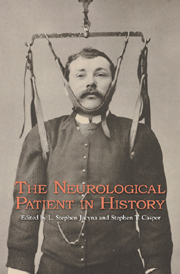Book contents
- Frontmatter
- Contents
- Preface
- Acknowledgments
- Introduction
- Part One Medicine Constructs the “Neurological Patient”
- Part Two Public and Private Constructions of the “Neurological Patient”
- Part Three Patient Groups Construct the “Neurological Patient”
- Part Four The Patient Constructs the “Neurological Patient”
- 7 The Psychasthenic Poet: Robert Nichols and His Neurologists
- 8 The Encephalitis Lethargica Patient as a Window on the Soul
- Part Five Historians Construct the “Neurological Patient”
- Bibliography
- List of Contributors
- Index
8 - The Encephalitis Lethargica Patient as a Window on the Soul
from Part Four - The Patient Constructs the “Neurological Patient”
Published online by Cambridge University Press: 12 September 2012
- Frontmatter
- Contents
- Preface
- Acknowledgments
- Introduction
- Part One Medicine Constructs the “Neurological Patient”
- Part Two Public and Private Constructions of the “Neurological Patient”
- Part Three Patient Groups Construct the “Neurological Patient”
- Part Four The Patient Constructs the “Neurological Patient”
- 7 The Psychasthenic Poet: Robert Nichols and His Neurologists
- 8 The Encephalitis Lethargica Patient as a Window on the Soul
- Part Five Historians Construct the “Neurological Patient”
- Bibliography
- List of Contributors
- Index
Summary
The adoption of the neurobiological approach to psychiatric disorders was excited in 1845 by the German internist Wilhelm Griesinger (1817-68)—“We must in each case recognize that psychic disorders are disorders of the brain” —and by the Austrian physician Ernst von Feuchtersleben (1806–49)—“Every psychosis is at the same time a neurosis, because without mediation of nervous activity no psychic change is manifested.” This physiological view dominated psychiatric thought until the end of the nineteenth century, substantially sustained by the golden age of neuroanatomy that began in the 1860s. Technical developments allowed ever finer investigation of brain structure, and it appeared to be only a matter of time before the human mind and its disorders would all be explained by functions localizable in discrete areas of brain tissue.
The optimism of biological psychiatry, however, had faded somewhat by the beginning of the twentieth century. Despite intensive efforts, neuropathology had failed to identify brain lesions in either of the two major psychiatric disorder types defined by Emil Kraepelin (1856–1926) at the end of the nineteenth century: dementia praecox, in 1908 rechristened schizophrenia by Eugen Bleuler (1857–1939), and manic depressive psychosis. Under the influence of new psychological models of mental disease, including Freud's psychoanalytic theory, and partly because it facilitated the emancipation long sought by many psychiatrists from their neurological and internist colleagues, such neuroses-brain disorders without recognized neuropathology-were largely conflated with the category of functional disorders, in which the psychopathology directly involved only psychic phenomena, at a dynamic level distinct from that of nervous tissue organization.
- Type
- Chapter
- Information
- The Neurological Patient in History , pp. 184 - 212Publisher: Boydell & BrewerPrint publication year: 2012



